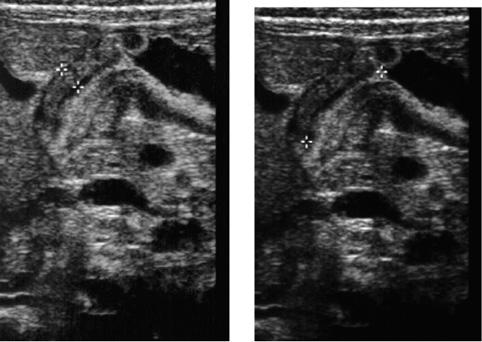Infantile Hypertrophic Pyloric Stenosis
Rachel Adams Greenup and Casey M. Calkins
 EPIDEMIOLOGY
EPIDEMIOLOGY
Infantile hypertrophic pyloric stenosis (IHPS) remains the most common surgical cause of nonbilious vomiting in infants.1 The incidence of pyloric stenosis ranges from 1 per 200 to 1 per 750 live births.
 PATHOPHYSIOLOGY AND GENETICS
PATHOPHYSIOLOGY AND GENETICS
The pyloric muscle appears to hypertrophy after birth, leading to gastric outlet obstruction. Proposed theories to explain the pathogenesis of infantile hypertrophic pyloric stenosis (IHPS) include decreased nitric oxide synthase production, altered enteric innervation, a lack of interstitial cells of Cajal, various infectious and environmental agents, hypergastrinemia, increased synthesis of epidermal growth factor, and congenital redundancy of the pyloric mucosa.2,3 Certain pharmacologic agents are known to increase the risk of IHPS in the newborn, including prostaglandin E2 infusion or erythromycin administration.4,5
Mode of inheritance is polygenic and modified by sex, with the incidence being 4 to 6 times higher in boys. Although it is believed to be more common in first-born males, birth order seems to be less influential than a smaller family size and higher socioeconomic status.6 The incidence of IHPS is twofold to threefold higher in African Americans than in those of European ancestry and it is rare in Asians. Recently, a genomewide association demonstrated linkage of IHPS with 2 loci on chromosomes 11q14-q22 and Xq23 that each harbor functional candidate genes that are members of the canonical transient receptor potential family of ion channels and have a potential role in smooth-muscle control and hypertrophy.7
 CLINICAL FEATURES AND DIFFERENTIAL DIAGNOSIS
CLINICAL FEATURES AND DIFFERENTIAL DIAGNOSIS
The typical age of presentation of IHPS is between 3 to 8 weeks old. Patients present with postprandial, forceful, nonbilious emesis, often referred to as projectile. The infant remains hungry and eager to feed after vomiting. When diagnosis is delayed, prolonged vomiting may lead to dehydration, weight loss, and development of a hypochloremic hypokalemic alkalosis. Additionally, fewer than 5% of patients develop an unconjugated hyperbilirubinemia thought to result from inadequate glucose absorption and an inability to maintain glucuronyl transferase activity.

Stay updated, free articles. Join our Telegram channel

Full access? Get Clinical Tree


